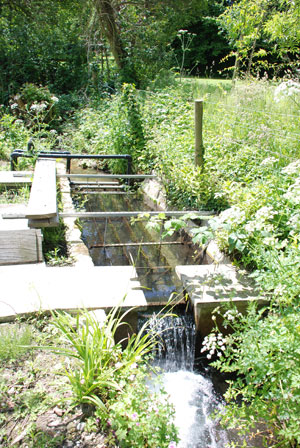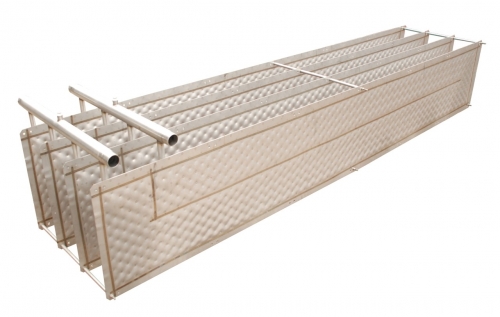When correctly specified, these can be extremely effective but they can require a considerable area of lake or water course to optimise efficiency. They can also represent an extended fouling hazard to navigation and fishing. Where silting requires regular dredging, it is more complicated to remove the “Slinkies” to facilitate this.
 The alternative to “Slinkies” has been to install plates, much like radiators, into the water to provide the heat exchanger function. There are a number of products on the market but advances in this technology have not been developed for many years. However, the arrival of the Energy Blade 3k4 system has changed this situation considerably.
The alternative to “Slinkies” has been to install plates, much like radiators, into the water to provide the heat exchanger function. There are a number of products on the market but advances in this technology have not been developed for many years. However, the arrival of the Energy Blade 3k4 system has changed this situation considerably.
The Energy Blade has been developed specifically with closed-loop energy harvesting in mind. The specification of the Blade surface and of the internal structure have been designed to optimise energy transfer whilst minimising pressure losses. The Blade configuration results in a very neat package which can be deployed in almost any situation where the minimum water depth can be maintained.
The standard Energy Blade 3k4 product comprises of four individual Blades packaged into a pre-plumbed set with single flow and return couplings from the integral manifold. The packaged set dimensions are approximately 3,000mm x 500mm x 800mm and the Blades are cross-linked for rigidity. Sets of Blades can be cascaded to support large compressor capacities. Installations will typically run with 25% propylene glycol thermal transfer fluid at a flow rate of about 1.2 l/s per 3k4 set. The standard material specification is ST/STL 304-2B stainless steel but alternatives are available for very specialised applications where increased resistance is required. Couplings can be specified in brass or stainless steel. Flow and return pipework can be MDPE as usual for ground-source collector arrays.
As for any water source heat exchanger, the sustainable energy harvesting rate depends upon the temperature of the water, flow rate across the Blades, the flow rate in the Blades and the target brine flow & return temperatures. As a guide, the following total system power outputs can be anticipated :
|
System power output supported by a 3k4 Energy Blade set |
|
|
Stagnant water |
10 kW |
|
Slow moving water |
15 kW |
|
Rapid moving water |
18 kW |
|
“White water” |
22 kW |
The thermal transfer fluid volume in Energy Blade installations can be considerably lower than in equivalent “slinky” schemes. In bodies of water with little to no flow, the costs of deploying Energy Blades and “slinkies” are comparable but in moving water, the increased efficiency of energy transfer in the Blades reduces costs per kW considerably. Therefore, in narrow streams and man-made channels, such as redundant mill races or leats, the 3k4 Energy Blade is an ideal choice. Naturally, all the Environment Agency requirements need to be met as when deploying any thermal or kinetic energy harvesting technology into water.
The compact configuration of the Energy Blade system makes it simple to deploy and easy to remove for dredging or other water course maintenance. The Blades can free-stand on a suitable solid base or can be slung under jetties, landing stages and bridges. Flow & return pipework can be landscaped out resulting in a very neat yet highly efficient outcome. Multiple sets of Blades can be coupled together to support larger capacity systems and alternative grades of stainless steel are available to special order for highly specialised applications.
The Energy Blade system is available through the sole distributor, Nuenta Ltd. - www.nuenta.com







